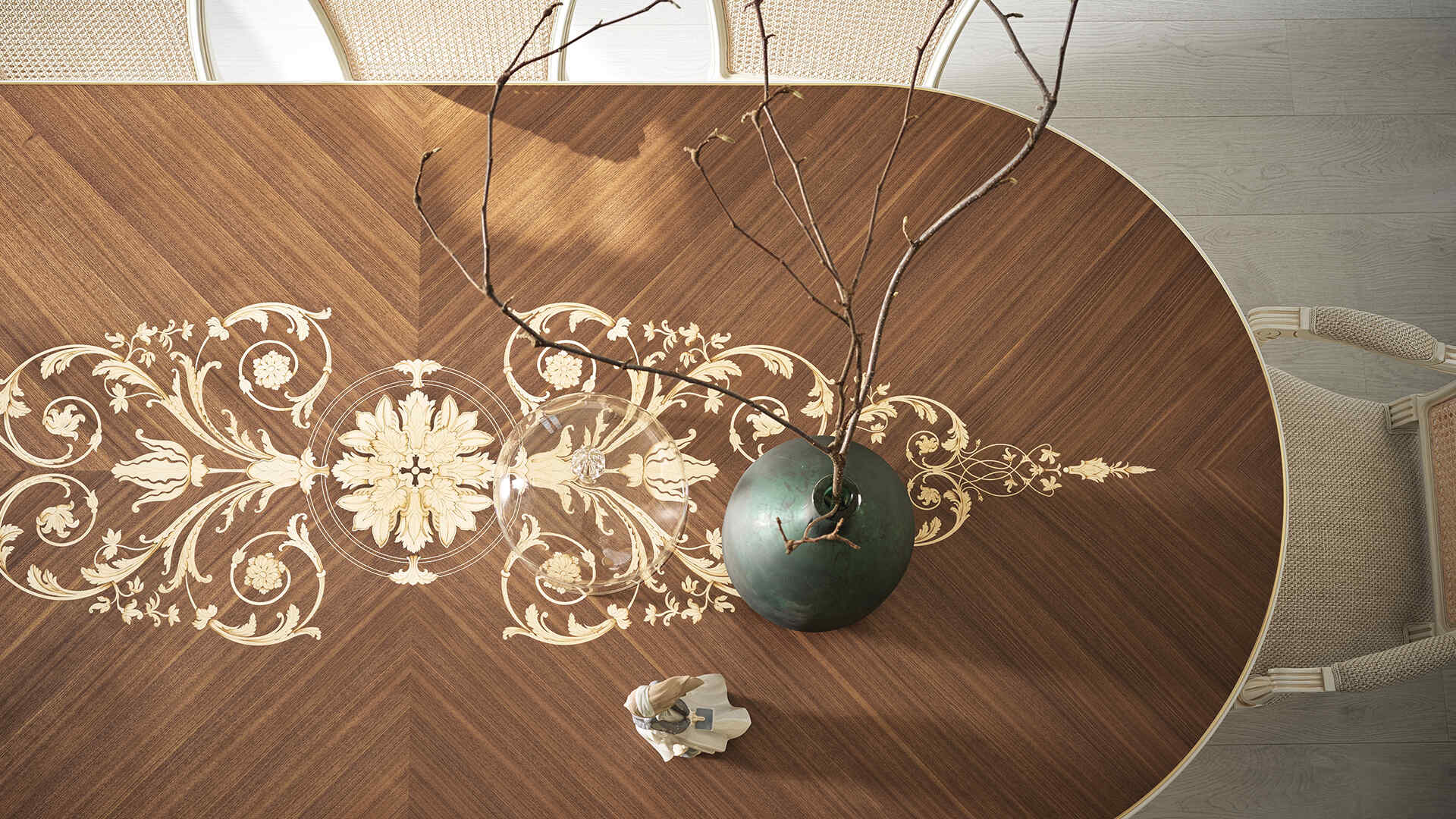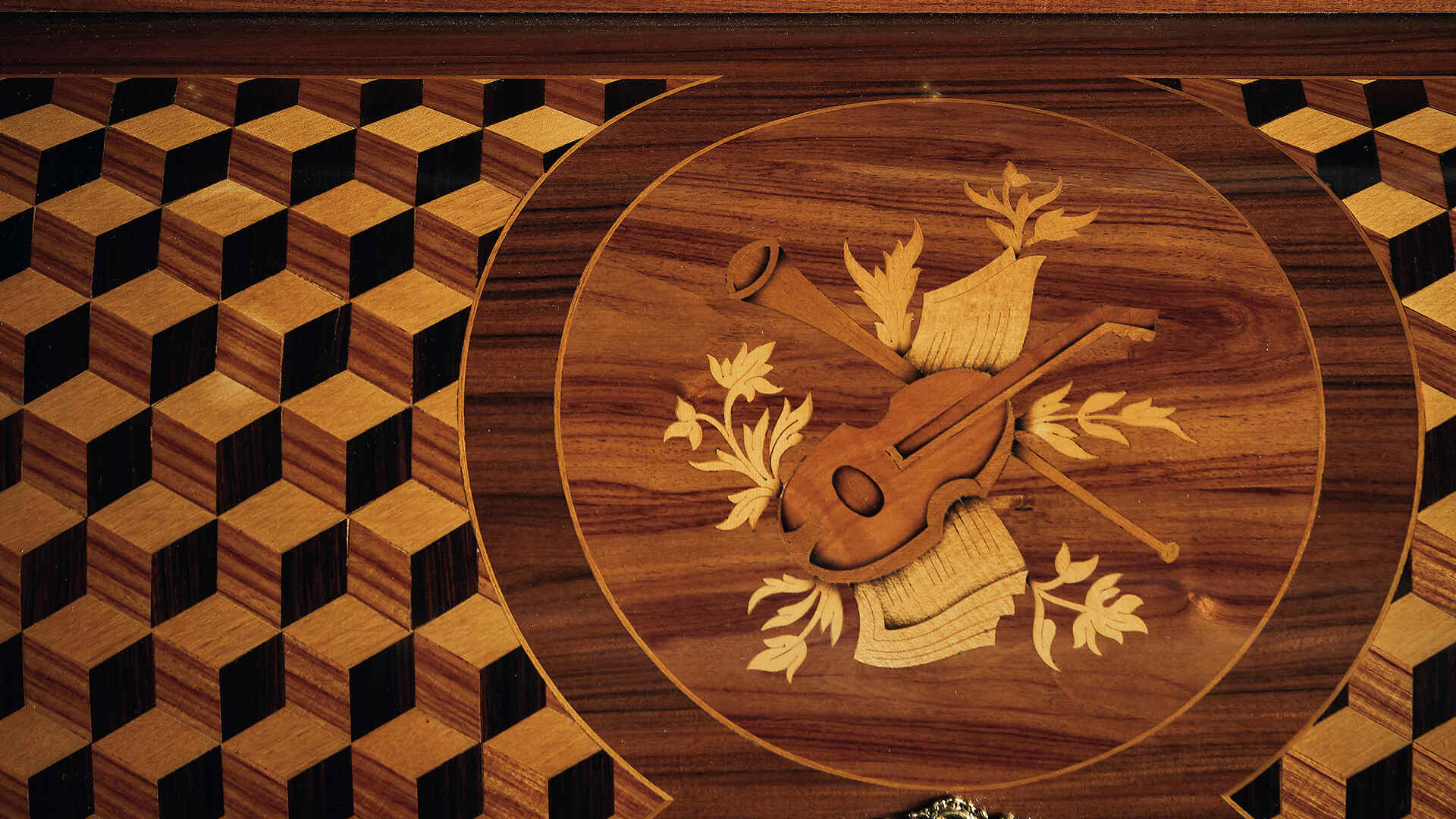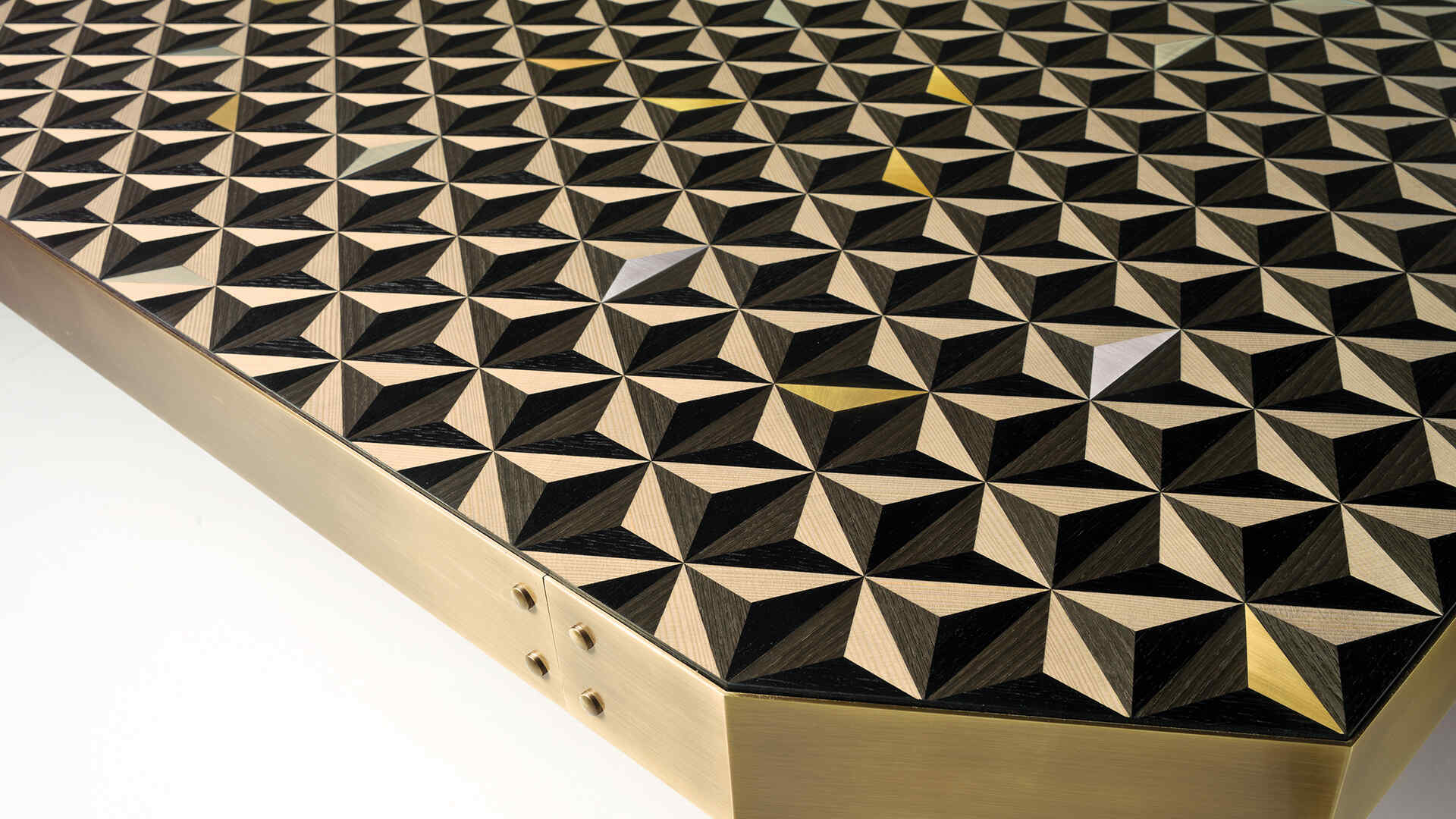
12 Sep Classic inlaid furniture: capturing the essence of a complex craft technique
Classic inlaid furniture: capturing the essence of a complex craft technique
Inlay is a traditional technique in the production of decorative furniture and showcases the highest level of design and craftsmanship. Despite the process dating back millennia – the first evidence of inlaid surfaces is seen during the Egyptian era, although different from modern methods – excellent examples can also be located in Italy (and more specifically in Tuscany), where inlay was used by the ancient Romans, with the name tarsia or intarsia, already around 300 AD.
However, around the Fifteenth century, inlay began to be enriched with plays of shadows and perspective, turning surfaces and pieces of furniture into intricate, stunning works of art and setting the inspiration for future generations of artisans – and, in modern times, interior designers. Back in the day, the craftsmen involved in this technique needed to understand the principles of perspective since inlay frequently reproduced figurative sceneries, naturalistic motifs, and architectural vistas in a realistic way. During that time, antique inlaid furniture was equivalent to framed paintings, as the designs were created by renowned painters and were extremely exact and detailed, and hence, utterly complex to reproduce on wood surfaces.
As a manufacturing technique, inlay is considered among the epitomes of richness, prestige and complexity in decorative furniture, especially as it requires extraordinary precision in woodworking.
Simplifying the technique to the max, we could define inlay as the art of inserting contrasting materials in a base object or surface to create a more complex and elaborated artwork. It is a meticulous process that, today, still requires the assembly to be handmade to ensure the highest degree of finesse.
High-quality materials for classic luxury furniture
Inlay furniture during the Age of Enlightenment: showcasing prestige
Veneer inlays and inlay furniture experienced a comeback in both Europe and America in the 17th and 18th centuries. This is also the era where marquetry was extensively used. Contrary to inlay, which features embedding pieces in solid wood, marquetry features a slab made of various woods, sometimes combined with materials like ivory, tortoiseshell, mother-of-pearl, pewter, brass, and copper, subsequently put together like a puzzle to create highly detailed decorative elements.

Cabinetmakers and carpenters started experimenting with various veneers as trade routes grew and new wood essences were imported from various parts of the world. Additionally, they began employing more sophisticated cutting and shaping methods, enabling increasingly complex designs.
From a statement piece point of view and especially regarding interior design, inlaid furniture became popular among Europe’s aristocratic classes to highlight their social status and prestige. Highly qualified artisans used expensive wood essences like rosewood, mahogany, and satinwood to create ornate patterns and decorations on several pieces of furniture, such as desks, tables and cabinets.
Veneer inlays were also very common among the elite in America, but they were also utilized in cheaper dwellings to replicate the prestigious wood essences seen in Europe. In addition, American furniture manufacturers started experimenting with novel styles, frequently embedding natural components like flowers and leaves into their designs.
The usage of veneer inlays peaked in the 1920s and 1930s during the Art Deco era, reaching a new apex when designers started to combine bold geometric patterns with contrasting colors to produce eye-catching furniture.
At this time, new veneer-cutting methods and tools, such as the veneer saw and the veneer hammer, were also invented. These work instruments improved efficiency and allowed for more accurate cutting and shaping processes.
The luxury of classic design settings
The excellence of inlay furniture during the Art Deco era
As mentioned, veneer inlay design and application peaked in the 1920s and 1930s. In this era, inlay furniture seamlessly complemented the bold geometric shapes, vibrant colors, and contrasting materials that defined the very nature of Art Deco style. During this time, geometric designs created from contrasting veneers, including bright and dark woods, were frequently seen on display on various pieces of furniture and cabinetry.

Designers started experimenting with novel methods like intarsia, which used a variety of veneer kinds stacked in a mosaic-like pattern to produce intricate pictures and motifs. This process featured various designs and was applied to several pieces of furniture, including tables, desks, and cabinets – all typically featuring elaborate patterns and images.
While geometric patterns were employed as veneer inlays in Art Deco furniture, veneers were also considered crucial to produce more organic designs like sunburst motifs, zigzag patterns, and stylized flowers.
Given their stunning aesthetics, veneer inlays were still widely used in furniture design by the middle of the 20th century. Even though many manufacturers and designers started experimenting with more modern materials, such as plastic laminates, wood veneer inlays remained an extremely popular option due to their strength and beauty.
Around this time, the newly created vacuum pressing process allowed for a more accurate and practical application of veneers to a substrate. This technique allowed the design of even more complicated and finely detailed drawings, and its excellence is such that vacuum pressing is a process still extensively used today.
The persistence of this technique through the middle of the 20th century brought it straight to contemporary interior design companies and artisans. Due to its richness, creativity and originality, inlay furniture hence remains among the most sought-after solutions for classic interior design settings even in modern times.
Request reliable advice for your classic interior design project
Angelo Cappellini: mastering the art of inlay to create extraordinary luxury furniture
Inlay is an art and a complex craft technique that encompasses Angelo Cappellini’s extensive know-how, showcasing it in every detail.
Artisan tradition and manufacturing excellence are the pillars of the company’s expertise, as Angelo Cappellini has been preserving its traditional techniques and knowledge and handing them down from generation to generation to provide top-level classic furniture for the most diverse luxury settings. The brand’s passion and expertise in cabinetmaking is declined in furnishings and accessories that explore and interpret various classic styles, creating catalogs of utterly beautiful interior design solutions.
As already explored in this article, inlay is among the oldest and most complex techniques for woodworking and also an artistic discipline used by skilled master craftsmen in the decoration of furnishings and accessories. Angelo Cappellini uses inlay in its most virtuous and elegant declinations, paying homage to the company’s long tradition in cabinetmaking. For the brand, the traditional inlay technique consists of using different types of wood – cut manually by skillful artisans or by laser for the smaller sections – and then combining them to create designs inspired by everyday objects from different eras.

Angelo Cappellini’s century-old experience in developing this technique has made it possible to experiment with the use of new materials such as brass and mother-of-pearl to create more modern designs inspired by oriental cultures, as in the case of the Koi carp coupled with water lilies.
The company’s constant experimentation has also led to the development of geometric patterns composed of different wood essences and various types of metals, all with thicknesses of tenths of a millimeter joined manually to form contemporary designs. The Tessella collection is the one that shows this artistry, particularly on the dining tabletop and, increased in size, on the sideboard.

Explore the beauty of classic inlay furniture: contact Angelo Cappellini’s experts for your exclusive luxury design project.
